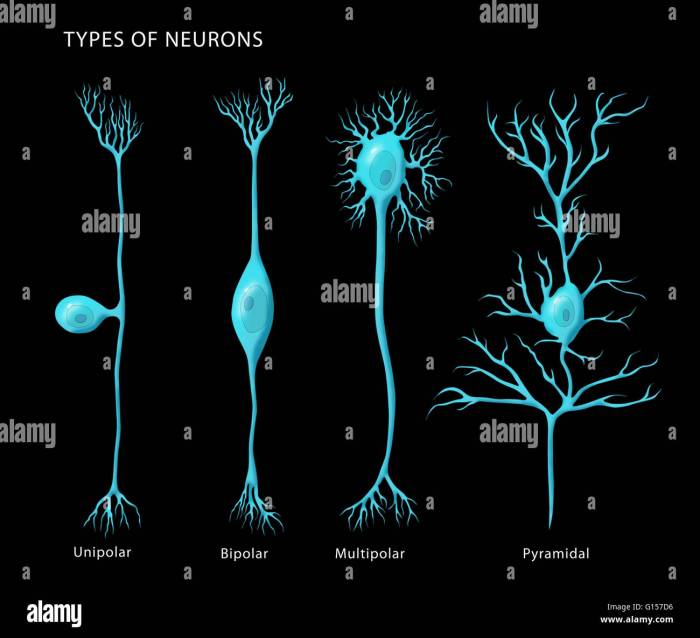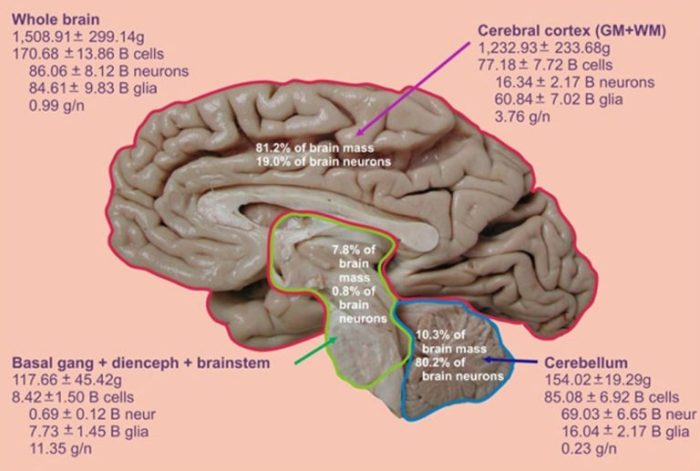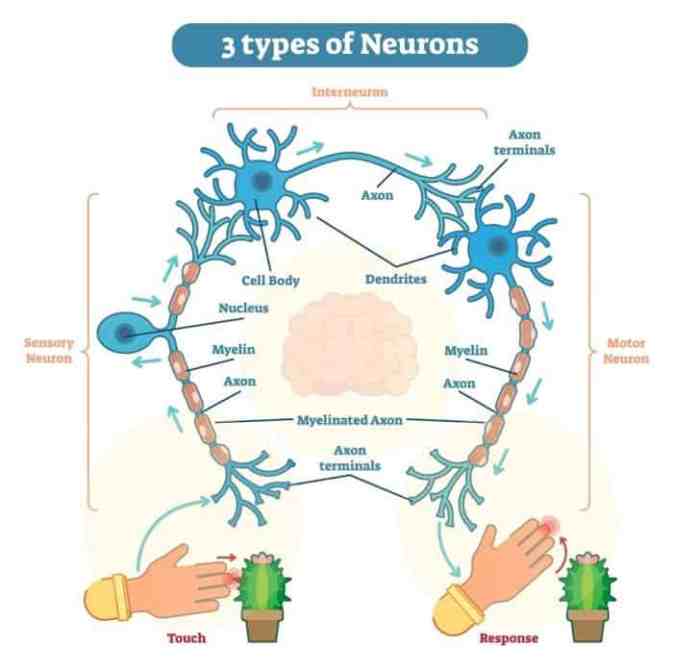How many neurons in the human body – How many neurons are in the human body? This question has puzzled scientists for centuries, and the answer is still not fully known. However, recent advances in technology have allowed us to get a better estimate of the number of neurons in the human brain and spinal cord.
The human nervous system is a complex network of cells that communicate with each other through electrical and chemical signals. Neurons are the basic units of the nervous system, and they are responsible for processing information and sending signals to other cells.
Introduction: How Many Neurons In The Human Body
The human nervous system is a complex network of cells, tissues, and organs that work together to control all bodily functions. The nervous system is made up of two main components: the central nervous system (CNS) and the peripheral nervous system (PNS).
The CNS consists of the brain and spinal cord. The brain is the control center of the body, and it receives and processes information from the senses, controls movement, and regulates bodily functions. The spinal cord is a long, thin bundle of nerves that runs from the brain down the back.
It carries messages between the brain and the rest of the body.
The PNS consists of all the nerves that connect the CNS to the rest of the body. The PNS includes sensory nerves, which carry information from the senses to the brain, and motor nerves, which carry messages from the brain to the muscles.
The human nervous system is an incredibly complex system, and it is responsible for everything from our ability to breathe to our ability to think. In this article, we will explore the number of neurons in the human body.
Methods for Estimating Neuronal Count
Estimating the number of neurons in the human body is a complex task, as there is no direct way to count them. Instead, scientists have developed various methods to estimate this number, each with its advantages and limitations.
Dissection and Microscopy
One method involves dissecting brain tissue and examining it under a microscope. This allows researchers to count neurons directly, but it is a time-consuming and labor-intensive process that can only be performed on small samples of tissue.
Stereology
Stereology is a statistical method that uses a series of two-dimensional sections to estimate the volume of a three-dimensional object. By applying this method to brain tissue, researchers can estimate the total number of neurons in a given region.
Magnetic Resonance Imaging (MRI), How many neurons in the human body
MRI is a non-invasive imaging technique that can be used to measure the volume of different brain regions. By combining MRI data with estimates of neuronal density, researchers can estimate the total number of neurons in the brain.
Positron Emission Tomography (PET)
PET is a nuclear medicine imaging technique that can be used to measure the metabolic activity of neurons. By combining PET data with estimates of neuronal density, researchers can estimate the total number of neurons in the brain.
Examples of Studies
- A study published in the journal “Nature” in 2012 used stereology to estimate that the human brain contains approximately 86 billion neurons.
- A study published in the journal “Science” in 2014 used MRI to estimate that the human brain contains approximately 100 billion neurons.
- A study published in the journal “NeuroImage” in 2016 used PET to estimate that the human brain contains approximately 110 billion neurons.
Historical Estimates
Determining the number of neurons in the human brain has been a subject of scientific inquiry for centuries. Early estimates, based on limited observation and dissection techniques, varied significantly.
One of the earliest attempts to estimate the number of neurons in the brain was made by the Italian anatomist Luigi Rolando in 1824. Using a microscope, Rolando estimated that the brain contained approximately 6 billion neurons. This estimate was later revised by the German anatomist Theodor Meynert in 1868, who estimated the number of neurons to be around 14 billion.
Key Scientists and Contributions
- Santiago Ramon y Cajal:Spanish histologist who developed the Golgi staining technique, which allowed for the visualization of individual neurons. His work laid the foundation for the modern understanding of neuronal structure and function.
- Korbinian Brodmann:German neurologist who developed a cytoarchitectonic map of the cerebral cortex, dividing it into 52 distinct areas based on their cellular structure. His work provided a framework for understanding the organization of the brain.
- Paul Flechsig:German neurologist who developed a myelin staining technique, which allowed for the visualization of myelinated nerve fibers. His work contributed to the understanding of the connectivity of the brain.
Current Estimates

Current estimates of the number of neurons in the human body range from 86 billion to 100 billion. These estimates are based on a variety of techniques, including histological studies, magnetic resonance imaging (MRI), and diffusion tensor imaging (DTI).
Distribution of Neurons
Neurons are not evenly distributed throughout the brain and spinal cord. The cerebral cortex, which is responsible for higher-order cognitive functions such as language, memory, and reasoning, contains the largest number of neurons, with an estimated 14-16 billion neurons. The cerebellum, which is responsible for motor coordination and balance, contains an estimated 69 billion neurons.
The spinal cord contains an estimated 1 billion neurons.
Significance of Estimates
These estimates of the number of neurons in the human body are important for understanding brain function. The number of neurons in a particular brain region is correlated with its computational power. For example, the cerebral cortex, which contains the largest number of neurons, is also the most computationally powerful region of the brain.
Comparison to Other Species

The human brain is often considered the most complex organ in the known universe, and its vast network of neurons is a key factor in our cognitive abilities and behavior. However, how does the number of neurons in the human body compare to that of other species?
And what implications do these differences have for our understanding of intelligence and consciousness?
Neuronal Count in Different Species
- Humans:Approximately 86 billion neurons
- Chimpanzees:Approximately 39 billion neurons
- Dolphins:Approximately 39 billion neurons
- Elephants:Approximately 257 billion neurons
- Mice:Approximately 75 million neurons
- Fruit flies:Approximately 100,000 neurons
As we can see from this list, there is a wide range of variation in neuronal count across different species. Humans have a significantly higher number of neurons than most other animals, but we are not the only species with a large brain.
Elephants, for example, have a larger brain and more neurons than humans. However, it is important to note that brain size and neuronal count are not always directly correlated with intelligence.
Implications for Cognitive Abilities and Behavior
The number of neurons in an animal’s brain is thought to be a major factor in its cognitive abilities. Animals with more neurons tend to be more intelligent, have better memory, and are able to solve more complex problems. However, there are other factors that also contribute to intelligence, such as the size of the brain, the number of connections between neurons, and the efficiency of those connections.
Nevertheless, the number of neurons in the human brain is a key factor in our ability to think, learn, and create. It is what allows us to have complex language, to understand abstract concepts, and to experience the full range of human emotions.
Conclusion
The number of neurons in the human body is a testament to the complexity of our brains and the power of our minds. While we may not have the most neurons of any species, we have a unique combination of brain size, neuronal count, and connectivity that allows us to achieve great things.
Factors Influencing Neuronal Count

The number of neurons in the human body is not fixed and can vary based on several factors. These factors include genetics, environment, and lifestyle, which all play a role in neuronal development.
Genetics
- Genes provide the instructions for building and maintaining neurons.
- Variations in genes can lead to differences in neuronal count.
- For example, some genetic mutations have been linked to neurodevelopmental disorders that affect neuronal development.
Environment
- Environmental factors such as nutrition, exposure to toxins, and stress can influence neuronal development.
- For example, malnutrition during pregnancy has been linked to reduced neuronal count in the developing brain.
Lifestyle
- Lifestyle factors such as exercise, sleep, and diet can also affect neuronal health.
- For example, regular exercise has been shown to promote neurogenesis, the process of new neuron formation.
These factors can contribute to individual differences in cognitive abilities. For example, people with higher neuronal counts in certain brain regions may have better memory or attention.
Concluding Remarks
The number of neurons in the human body is truly staggering, and it is a testament to the complexity of the human brain. These neurons allow us to think, feel, and move, and they are essential for our survival. As we learn more about the human brain, we will gain a better understanding of ourselves and our place in the world.
Essential Questionnaire
How many neurons are in the human brain?
The human brain contains an estimated 86 billion neurons.
How many neurons are in the human spinal cord?
The human spinal cord contains an estimated 10 billion neurons.
How many neurons are in the human body?
The human body contains an estimated 100 billion neurons.